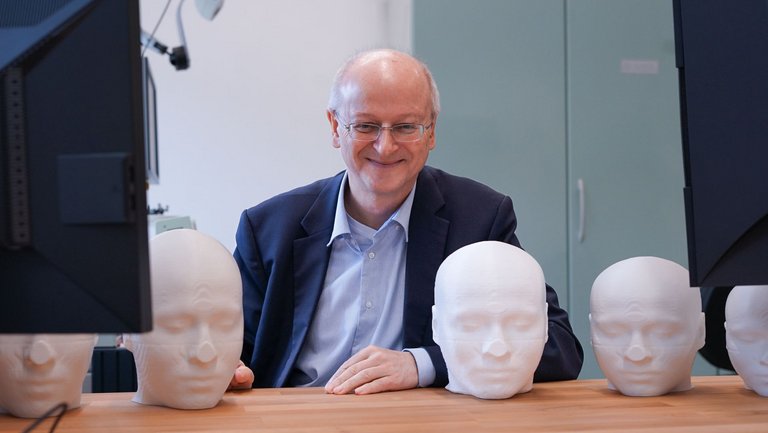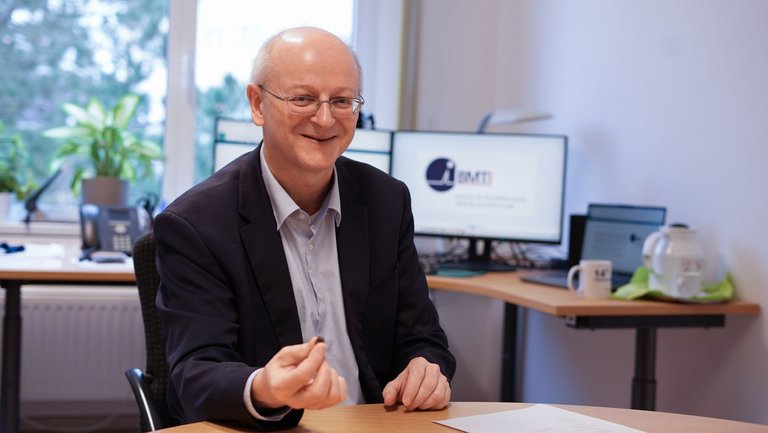A wet head can save lives during thunderstorms - this has been known since the team led by Prof. Jens Haueisen and Prof. Michael Rock published the results of their research on lightning discharges in the renowned journal Springer Nature Scientific Reports. The scientists have succeeded in demonstrating that rainwater on the scalp can reduce damage caused by direct lightning strikes to the head. But what else can protect against lightning strikes and do the measures help everyone equally well? The head of the Institute of Biomedical Engineering and Informatics (BMTI) and the Biomedical Engineering Group at TU Ilmenau is currently investigating these questions. In UNIonline, Prof. Haueisen provides exciting insights into his research, which could be used to provide patients with more gentle respiration after operations and treat eye diseases thanks to the application of electricity.

Prof. Haueisen, you are probably being asked this question a lot at the moment, but does a wet head really help during thunderstorms?
There is no general answer to this question because it depends on the water. It has to be conductive. Rainwater has specific properties, a certain conductivity that not all water has.
How did you find out that rainwater on the scalp can reduce damage from direct lightning strikes to the head?
We measured this in experiments on artificial heads. These were modeled on human heads and reproduce the main layers of a head - skin, skull and the interior. Our focus was on the electrical properties - i.e. conductivity and permittivity.
How were the model heads produced?
First of all, we had a medical imaging data set of a test subject, which was segmented into the three main components of the head. We produced the model heads on this basis. They are made of materials that mimic the properties of human tissue. The outer part, the skin, consists mainly of agar, a material obtained from algae that is also used in the food industry. This replicates the tissue and models the properties that are electrically relevant.
The skull is made of a type of plaster which, like the skin layer, has been enriched with various materials in order to create conductivity and permittivity and to achieve appropriate mechanical stability. The inside is just sodium chloride solution, i.e. salt water.
The models do not last long, as they are made of organic material and are usually destroyed after the experiment.
Will you continue your research into lightning strikes?
Yes, we are already doing that. We are currently working on developing an average head. Human heads are basically similar, but not the same. They differ in size and shape. To do this, we have analyzed around 5000 data sets that cover the variability of the population. We will use this to design an average head.
Why do you design such an average head?
Using a model of a single person's head, we have found that rainwater reduces the damage caused by lightning strikes. Now we want to investigate whether different head shapes lead to a different effect.
We are investigating many questions, for example, what happens in the event of a lightning strike if someone is wearing a hat? Or is it better to wear a hat or cap in a thunderstorm?
In addition to your research on lightning discharges, you are working on a number of research projects at the BMTI on the early detection, diagnosis, treatment and rehabilitation of diseases. What range of biomedical engineering does the institute cover and what are your research priorities?
Our research focuses on measurement and stimulation technology in humans. We deal with both the hardware, the device technology, and the software, for example data analysis. The technology is mostly non-invasive, i.e. it does not penetrate the skin.
We also research and develop technology for ophthalmology, ophthalmological technology. We deal with optical systems and electrical stimulation of the eye as well as technology that contributes to general eye diagnostics.
We also conduct basic research in the field of neuroscience.
Her colleague, Prof. Patrique Fiedler, has developed so-called dry electrodes at the BMTI, which can be attached to patients without gel and are already being used in a variety of medical applications. You are also researching other types of electrodes. Are there currently any exciting research projects in this area?
We are currently working on electrical stimulation of the eye in a study supported by the German Research Foundation. The project is called VIRON. We are attaching individual electrodes around the eye. They apply a weak current that activates the cells in the eye. A previous study, albeit on a small scale, has already shown that this stimulation can be helpful in glaucoma. Together with a number of clinics, we have now started a large clinical study in which around 300 glaucoma patients are being tested throughout Germany. Our institute calculates the optimal electrode position for the patients. Specifically, we are testing two situations: so-called standard stimulation, where the electrodes are attached to the right and left of the eye, and stimulation in which they are optimally distributed around the eye. The geometry of the individual patient is used to calculate the best way to distribute the current.
In the eVENT project, you are developing a new method for artificial ventilation during operations. Why do we need a new method at all?
The project name stands for electroventilation and means that the phrenic nerve, which supplies the diaphragm and ensures that we breathe in the sense of muscle contraction, is electrically stimulated. This is difficult to achieve non-invasively. The basic idea behind mechanical ventilation during surgery is positive pressure ventilation. With natural breathing, on the other hand, we breathe with negative pressure. A tube is often inserted into the patient's throat. The disadvantage of positive pressure is that it can lead to side effects, so-called ventilator-initiated diseases - from infections to lung damage. Many thousands of patients are affected by this.
Another problem is weaning: as soon as you stop breathing on your own, the respiratory muscles regress. Even after operations, patients are often still ventilated by machine. The respiratory muscles begin to regress after just a few hours. Within days, this becomes a serious problem. Patients have to be weaned off the ventilator again, the technical term is "weaning". They have to train themselves to breathe again over many days and sometimes weeks. With electrical stimulation, we could support them in this by stimulating the diaphragm and gently training the respiratory muscles.
What are the advantages of non-invasive stimulation of the phrenic nerve?
On the one hand, if used in good time, the muscle does not regress as far. On the other hand, it can support people who need to rebuild their respiratory muscles. The weaning time is shortened.
Kontakt
Prof. Jens Haueisen
Head of the Institute of Biomedical Engineering and Informatics


